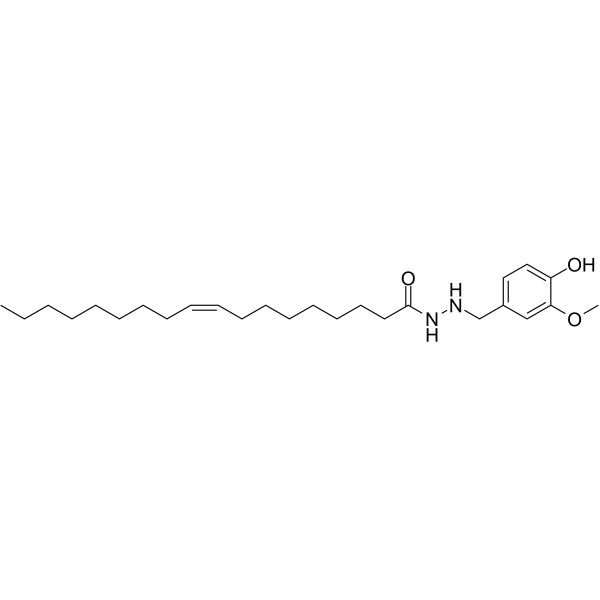
OMDM-5
CAS No. 616884-66-3
OMDM-5( —— )
Catalog No. M26348 CAS No. 616884-66-3
OMDM-5 is a potent vanilloid receptor type 1 (TRPV1, EC50 = 75 nM) agonist, showing weak ligand activity at cannabinoid type 1 receptor (CB1, Ki=4.9 μM).
Purity : >98% (HPLC)
 COA
COA
 Datasheet
Datasheet
 HNMR
HNMR
 HPLC
HPLC
 MSDS
MSDS
 Handing Instructions
Handing Instructions
| Size | Price / USD | Stock | Quantity |
| 5MG | 302 | Get Quote |


|
| 10MG | 447 | Get Quote |


|
| 25MG | 714 | Get Quote |


|
| 50MG | 1017 | Get Quote |


|
| 100MG | 1368 | Get Quote |


|
| 500MG | 2673 | Get Quote |


|
| 1G | Get Quote | Get Quote |


|
Biological Information
-
Product NameOMDM-5
-
NoteResearch use only, not for human use.
-
Brief DescriptionOMDM-5 is a potent vanilloid receptor type 1 (TRPV1, EC50 = 75 nM) agonist, showing weak ligand activity at cannabinoid type 1 receptor (CB1, Ki=4.9 μM).
-
DescriptionOMDM-5 is a potent vanilloid receptor type 1 (TRPV1, EC50 = 75 nM) agonist, showing weak ligand activity at cannabinoid type 1 receptor (CB1, Ki=4.9 μM). OMDM-5 is a selective anandamide cellular uptake (ACU) inhibitor(Ki = 4.8 μM).
-
In Vitro——
-
In Vivo——
-
Synonyms——
-
PathwayGPCR/G Protein
-
TargetCannabinoid Receptor
-
Recptor——
-
Research Area——
-
Indication——
Chemical Information
-
CAS Number616884-66-3
-
Formula Weight432.649
-
Molecular FormulaC26H44N2O3
-
Purity>98% (HPLC)
-
Solubility——
-
SMILESCCCCCCCC\C=C/CCCCCCCC(=O)NNCc1ccc(O)c(OC)c1
-
Chemical Name——
Shipping & Storage Information
-
Storage(-20℃)
-
ShippingWith Ice Pack
-
Stability≥ 2 years
Reference
1.Zhao R, Zhao X, Gao X. Molecular-level insights into intrinsic peroxidase-like activity of nanocarbon oxides. Chemistry. 2015 Jan 12;21(3):960-4.
molnova catalog



related products
-
CB2R PAM
CB2R PAM is an orally active cannabinoid type 2 receptor (CB2Rs) positive allosteric modulator that enhances CP 55940 and 2-Arachidonylglycerol-stimulated [35S]GTPγS binding to CB2 receptors without affecting receptor activity in the absence of agonists.
-
PrNMI
PrNMI is a peripherally restricted cannabinoid 1 receptor (CB1R) agonist.
-
Taranabant
A potent, selective and orally active cannabinoid-1 receptor (CB1R) inverse agonist with IC50 of 2.8 nM, Ki of 0.13 nM.



 Cart
Cart
 sales@molnova.com
sales@molnova.com


